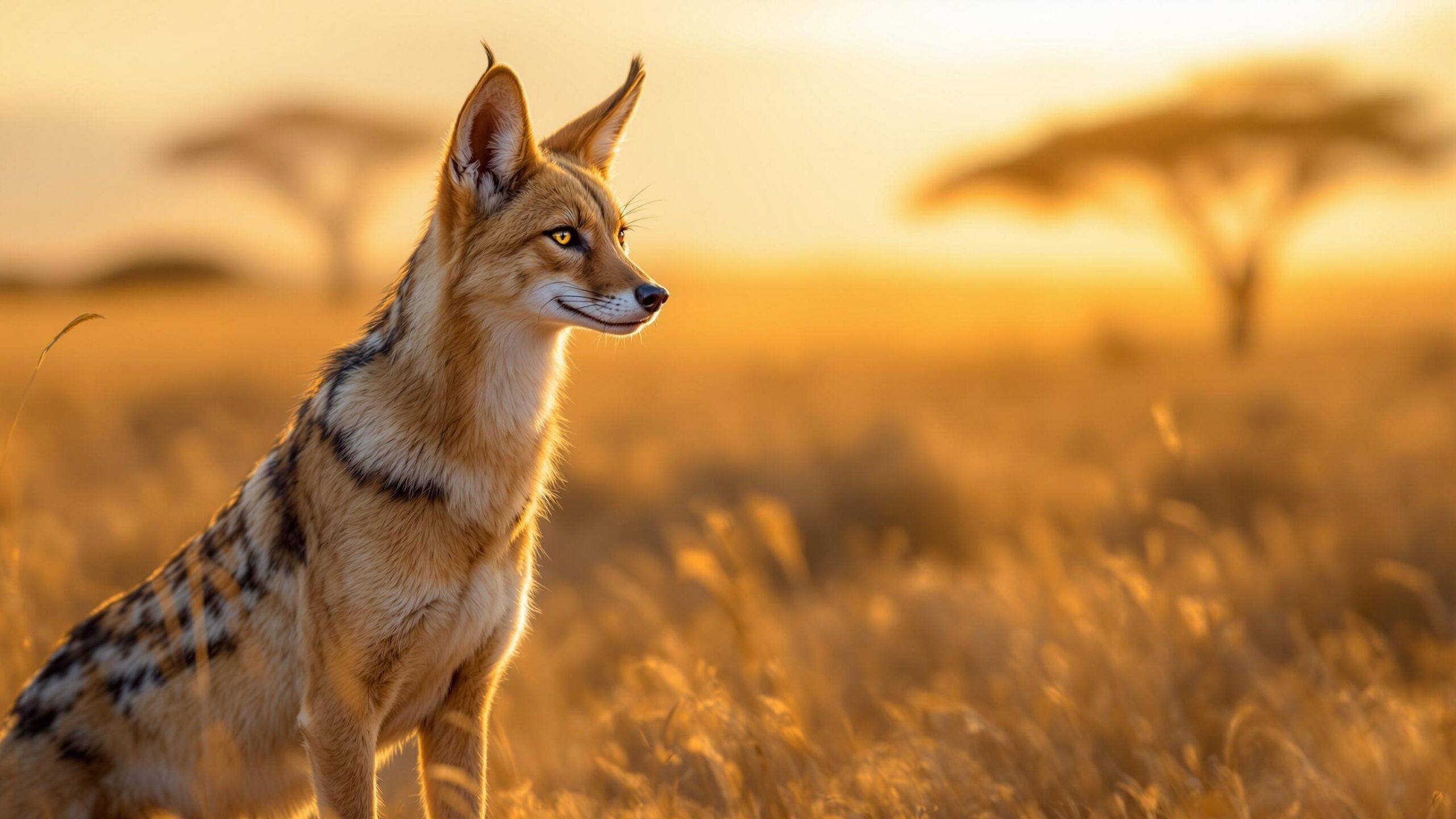Jackals: The Sly Survivors of the Wild Who Thrive in the Shadows
As dusk paints the savanna in molten gold and shadows stretch long across the landscape, a figure emerges—not with the brute force of a lion or the silence of a leopard, but with the cunning grace of a born opportunist. With sharp eyes, keen ears, and a nose that can catch the scent of a meal from miles away, the jackal enters the scene. Neither fully predator nor purely scavenger, the jackal is a symbol of adaptability, balance, and resilience. From African grasslands and deserts to Eurasian scrublands and Himalayan foothills, jackals have carved out a niche by dancing along the edge of survival, thriving in both the wilderness and the margins of human civilization.
Jackals, belonging to the Canidae family alongside wolves, coyotes, foxes, and domestic dogs, are not one uniform species but a category of clever, resourceful canids found primarily in Africa and Asia. Their reputation in folklore often paints them as sly tricksters or eerie night howlers, but in reality, they play an essential ecological role. As hunters, scavengers, and cleanup crews, jackals help keep ecosystems in balance, and their diverse behaviors reflect the environments they call home. Understanding jackals means understanding the art of survival—where intelligence, cooperation, and adaptability are more powerful than size or strength.
Anatomy of Intelligence: The Biology and Behavior of Jackals
Jackals typically weigh between 15 and 30 pounds, with long legs, bushy tails, and a fox-like face marked by sharp features and intelligent eyes. Their coats vary depending on species and region, often providing ideal camouflage in arid and semi-arid environments. Whether clad in golden hues or ash-gray patterns, jackals blend into their surroundings with ease.
One of the most impressive features of jackals is their communication. They use an array of vocalizations—yips, barks, howls, and whines—to coordinate with mates and warn rivals. These vocal cues, combined with scent marking and body language, help jackals maintain territories and social bonds. Unlike many solitary carnivores, jackals often operate in monogamous pairs, raising pups together in dens and cooperating closely to hunt and defend their range.
Their diet is as flexible as their behavior. Jackals are omnivores, capable of hunting rodents, birds, and reptiles, scavenging carrion, and supplementing their meals with fruit, insects, and even roots. This dietary adaptability is a key factor in their wide distribution and long-term success in changing ecosystems.
The Golden Jackal: Widespread and Wonderfully Adaptive
The golden jackal (Canis aureus) is the most widespread of all jackal species, found across North and East Africa, the Middle East, and much of southern Asia, including India and Southeast Asia. It is also the most wolf-like in appearance, with a thick golden to tawny coat and a sharp, alert posture. Golden jackals thrive in a remarkable range of habitats—from the Nile Delta to the forests of Sri Lanka, from suburban farmland to remote savannas. Their success stems from a perfect blend of behavioral flexibility and ecological generalism. In Africa, they may trail behind lions and hyenas to scavenge leftovers. In India, they patrol rice paddies and orchards, preying on rats and raiding fruit trees. In Europe, where their range is expanding into the Balkans and beyond, they’re emerging as one of the most resilient wild canids of the continent. Golden jackals usually form lifelong pair bonds, raising litters of pups in underground dens. During breeding seasons, older siblings may stay behind to assist in raising the new litter—a cooperative breeding strategy that increases pup survival. Their haunting wails, often mistaken for those of coyotes, form a nightly chorus in many rural landscapes, a sound both ancient and strangely modern.
The Black-Backed Jackal: The Painted Predator of Africa
If the golden jackal is a generalist, the black-backed jackal (Canis mesomelas) is a specialist in the art of boldness. Native to eastern and southern Africa, particularly Namibia, Botswana, Kenya, and South Africa, this species is known for its distinctive black saddle-like marking down the back, contrasted against rich russet flanks and legs. It is perhaps the most elegant and visually striking of the jackals. Black-backed jackals are highly territorial, with mated pairs patrolling fixed home ranges and defending them with fierce determination. Unlike golden jackals, which may tolerate communal overlaps, black-backed jackals draw hard boundaries. This territoriality comes with a confident hunting style—they often hunt larger prey than expected for their size, including young antelope, flamingos, and hares. They’re also adept scavengers, boldly stealing scraps from lions or hyenas when the opportunity arises. Their dens are typically located in burrows or thickets, and pups are raised with the aid of older siblings. Black-backed jackals are particularly vocal, using a variety of barks, growls, and screams to maintain territory and family cohesion. Their presence in a region often signals a healthy, biodiverse environment where predator-prey dynamics are well intact.
The Side-Striped Jackal: The Quiet Forager of the Forest Fringe
The side-striped jackal (Canis adustus) is the most elusive of the African jackals, found primarily in central and western Africa’s more humid, wooded habitats. It is distinguished by its grizzled gray coat and a pale stripe running along each side of the body from elbow to hip, often less vibrant than the markings of its cousins.
Side-striped jackals are more reserved and less vocal than their golden and black-backed relatives. They tend to avoid open spaces, preferring the edge of woodlands, brushlands, and riverine forests. Their diet leans heavily toward invertebrates, small mammals, fruit, and carrion, and they are less likely to engage in confrontational scavenging. They also forage alone more often and may hunt amphibians, reptiles, and even fish along riverbanks.
Their more solitary and nocturnal lifestyle reflects the ecosystems they inhabit—denser, quieter, and less open to dramatic chases or showdowns. Nevertheless, side-striped jackals play an essential role in cleaning up carrion and controlling rodent and insect populations, contributing to the health of African forest-edge environments.
Eurasian Expansion: The New Frontier of the Jackal
One of the most surprising ecological stories of the 21st century is the golden jackal’s expansion into Europe. Once limited to southeastern regions, golden jackals are now spreading into Germany, Switzerland, Austria, and even the Netherlands. This expansion is largely due to the reduction of wolf populations (now beginning to rebound), climate change, and land-use changes that have opened up new habitat corridors. Unlike wolves, golden jackals are generally not perceived as a major threat to livestock or humans, which has allowed them to expand with little opposition. In their new European ranges, jackals occupy a similar niche to red foxes and badgers, scavenging roadkill, controlling rodent populations, and feeding on agricultural surplus.
Scientists are studying these populations closely to understand how golden jackals adapt to colder climates and human-dominated landscapes. Their arrival has sparked debate over native versus invasive status, but many ecologists now recognize them as a natural part of Europe’s shifting biodiversity mosaic—a pioneer species navigating a human-altered world.
Myth, Legend, and Misunderstanding: Jackals in Culture
Jackals have long occupied a prominent place in human mythology. In ancient Egypt, the god Anubis—guide to the afterlife and guardian of tombs—was depicted with a jackal’s head, likely inspired by the golden jackals that roamed burial grounds. In Hindu mythology, the goddess Kali is often accompanied by jackals, representing the boundary between life and death, wildness and wisdom. In African folktales, the jackal is often the trickster—cunning, clever, and occasionally heroic. It outwits stronger animals, teaches lessons through mischief, and reveals the world’s contradictions. These tales reflect real ecological truths: jackals are survivors, thinkers, and opportunists. They succeed not through brute force, but through brains, adaptability, and persistence.
Yet with myth has also come misunderstanding. In many rural areas, jackals are seen as nuisances or livestock thieves, despite their actual impact often being negligible compared to other predators. Conservation efforts must work not only to protect jackal habitats but to reshape outdated perceptions and celebrate the jackal’s ecological value and cultural legacy.
Jackals and Ecosystem Balance: Unsung Heroes of the Food Web
Though often overshadowed by lions, wolves, and hyenas, jackals play a crucial role in keeping ecosystems balanced. As mesopredators, they control populations of small mammals and birds that might otherwise overrun vegetation or spread disease. Their scavenging helps reduce the spread of pathogens from decomposing carcasses, especially in areas without large vultures or other cleaners. In human-modified landscapes, jackals act as a natural pest control service. In agricultural areas, they help suppress rodent populations. In tourist reserves and national parks, they dispose of leftover kills and roadkill, maintaining cleanliness and health.
Yet jackals are also vulnerable to ecological shifts. When apex predators are removed, jackal populations can rise unchecked—leading to imbalances. Conversely, where human development has fragmented their habitats, jackals may suffer from reduced food access, conflict with people, or genetic isolation. Understanding the jackal’s place in the food web helps conservationists create policies that support entire ecosystems.
Threats and Conservation: Walking the Fine Line Between Wild and Tame
Jackals, though adaptable, face a growing number of challenges. Habitat fragmentation due to agriculture, infrastructure, and urbanization is a major issue. As natural spaces shrink, jackals are forced into closer proximity with humans, increasing the likelihood of conflict, disease transmission, and persecution. In many parts of the world, jackals are hunted under outdated perceptions of them as threats to livestock or as competitors for game. Poisoning campaigns, snares, and habitat destruction all take their toll. And in expanding urban areas, road mortality is an increasing concern.
Conservation groups are beginning to pay more attention to these versatile canids. Protected areas, wildlife corridors, and education campaigns are crucial for their continued survival. Monitoring jackal populations—especially in new territories like Europe—is helping scientists anticipate ecological shifts and plan for coexistence. Public perception is also key. By reframing jackals as ecosystem allies rather than nuisances, conservationists can foster community support. Programs that involve local people—through ecotourism, storytelling, and school-based outreach—are proving effective at changing minds and ensuring these fascinating creatures continue to thrive.
Embracing the Wild Wisdom of the Jackal
To understand the jackal is to appreciate the beauty of balance. These animals are not the loudest, the biggest, or the most powerful—but they endure, adapt, and contribute with quiet consistency. They are intelligent, resilient, and vital. They remind us that survival isn’t just about dominance. Sometimes it’s about cooperation, cleverness, and courage in the face of change. Jackals are storytellers, in both myth and reality. Their lives mirror the shifting edges of wild and human spaces, and their continued success depends on how well we understand and respect those margins. They teach us that wildness still exists—in the glint of eyes beneath the bush at dusk, in the distant call that rises above a savanna wind, in the silent persistence of life navigating an uncertain future.
Now is the perfect time to follow that sound into the wild. Learn about the golden jackal’s rise across continents. Explore the family lives of black-backed jackals. Discover the forest secrets of the side-striped jackal. In every territory, on every continent they roam, jackals are waiting—not for attention, but for understanding.

